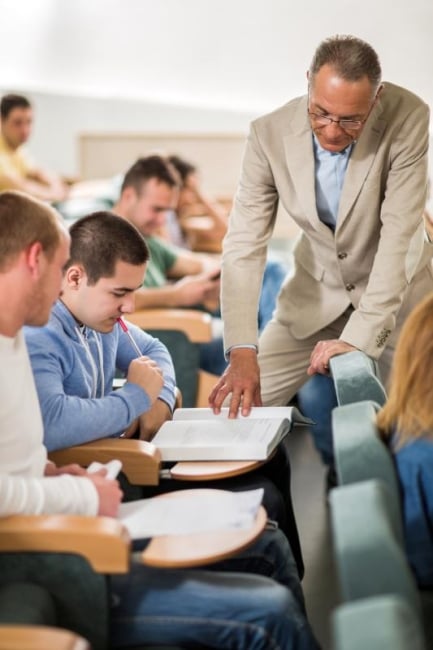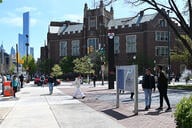You have /5 articles left.
Sign up for a free account or log in.

skynesher/E+/getty images
I’ve been a college president for more than 20 years and have been teaching college students for twice as long as that. Last semester, though, I had a new classroom experience—teaching my first group of high school students in a program sponsored by the National Educational Equity Lab, in partnership with Wesleyan University.
I’d first heard from an undergraduate about this nonprofit organization, which enables high school students from historically underserved communities to take actual college courses taught by college professors. He was enthused by its mission to bring college-level—and credit-bearing—courses to low-income high school students for free. The Wesleyan student knew of our efforts to put high-quality liberal arts education online, and he suggested we do so in a way that would benefit high schoolers who didn’t have the same range of opportunities to which he’d had access.
I was enthusiastic about Wesleyan becoming a partner with the Ed Equity Lab, as our missions are very much aligned. We are always looking for highly talented students who may not have had access to educational opportunities, and if we see their potential and enroll them, we will meet their full financial need with scholarships and without loans. The Ed Equity Lab’s mantra is “talent is evenly distributed—opportunity is not.” The organization works with Title I high schools, which means that at least 40 percent of their students qualify for free or reduced-price lunch. The principals at those schools join with classroom teachers to choose students ready for college-level work, even if sometimes the students themselves don’t realize how ready they are. The partner university chooses a professor and some teaching assistants to work with the high school instructor to deliver a class at the same level one would find at the university. Howard, Stanford and Yale Universities have become partners, and now Wesleyan joins them and some other colleges and universities in offering students a chance to earn college credit for free in high school.
But the point of the Ed Equity Lab work is much larger than offering a free credit-bearing course. The point is to give the students in underserved high schools a chance to excel at challenging intellectual work and show them that they belong in a top-notch college or university. Many of these students hadn’t considered applying to these kinds of institutions, and through these classes, they learn that they are capable of doing the work. They also learn that attending a top college would be affordable with the need-based scholarships the institutions offer. Many of these colleges and universities would be free for the students.
Although I was enthusiastic about partnering with Ed Equity Lab, I thought I’d recruit a colleague at Wesleyan to teach a course in a high-demand area. As it turned out, the professors we had in mind already had full schedules, and so I volunteered to offer The Modern and the Post-Modern, a humanities class I regularly teach in person and that I’d already offered as a MOOC with Coursera. We recruited some Wesleyan undergrads who had experience either with teaching or with this class to be the TAs, while Ed Equity found teachers and scores of students in about six high schools, and we were off and running.
My class is focused on Western ideas of modernity, progress, artistic experimentation and antifoundationalism from Rousseau and Kant through contemporary pragmatism and critical race theory. It’s tough going for many students, as we move quickly from Enlightenment to Romanticism, from radical critique to art for art’s sake. I’ve taught versions of the class for decades to first-year and graduate students, but I wondered what high school students would make of it.
Turns out that many were intimidated by starting out with Kant and Rousseau, but they gained confidence as they read Mary Shelley, Gustave Flaubert and Virginia Woolf. The high school teachers commented on how the class taught students “how to think more critically and analytically” and that writing and rewriting essays helped them to express themselves more clearly and concisely.
The material was “provocative”—we read Charles Baudelaire, Alison Bechdel and Toni Morrison!—and some even questioned its “appropriateness.” This was music to my ears. Having discussions about the borders of what we can talk about is much more empowering than policing those borders with the intention of “protecting” young minds. A student from Kansas said she enjoyed the discussions with the Wesleyan teaching assistants so much because she wasn’t pressured to have set opinions about issues. She was able to explore those issues and her own relation to them by listening to others. Learning to listen to others with whom one might disagree is a skill essential for civic participation—especially these days.
As Roberto, a student from California, said before quoting Nietzsche, “I am capable, we are capable … of succeeding, of adapting and evolving to be the best version of ourselves.”
There were bumps along the way. The material is hard, and some students found it daunting. One school had to drop out because of COVID, and various students had life events that prevented them from completing. But we were all impressed with the number of students who earned college credit by succeeding in grappling with the material and improving their writing.
We were also impressed in how the Wesleyan TAs connected with the high schoolers, building trust along with skills. Isn’t this what we look for in liberal education—learning to talk together about challenging subjects and enduring questions, inspired by powerful thinkers and artists? Max, a student from Florida, put it succinctly: “Insanely enlightening!”
We start off The Modern and the Post-Modern with Kant’s definition of Enlightenment: leaving behind self-imposed immaturity. That’s what my high school students did last semester. We treated them like adults, and they responded by thinking freely, working hard and listening to a variety of points of view. They earned college credit. Listening to them, I learned something, too. I learned at a very granular level about the great things that can happen when you distribute opportunity more widely. Administrators and professors at colleges and universities should create more opportunities to work with high school students. By cultivating paths to college for students from diverse backgrounds, we become better teachers and better citizens.




